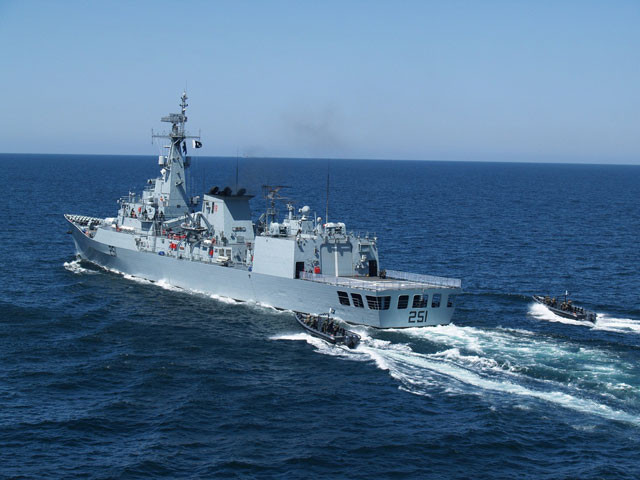Navy increases surveillance at Gwadar Port
Anticipates fresh security challenges with development of deep sea port

PHOTO: Irfan Ghauri
 PHOTO: Irfan Ghauri
PHOTO: Irfan GhauriIn a recent visit to the coastal belts of Gwadar and Karachi by journalists, PN officials revealed that the new division was deployed in anticipation of trade activities through Gwadar. Trade is expected to spring up under the China-Pakistan Economic Corridor project. The battalion is an addition to the existing troops securing the coastlines of Karachi Harbour and Sir Creek areas.
Officials briefed about the operational capabilities of the force, and the scope and scale of their operations. “Most of the Indian Ocean including Pakistan’s Exclusive Economic Zone (EEZ) was declared a high-risk area of piracy,” said a PN official, adding that they then enhanced security. As a result, after the Contact Group on Piracy off the Coast of Somalia revised limits of the piracy High-Risk Area last year, it excluded Pakistan’s EEZ.
Pakistan on the global chessboard
Apart from security measures, the navy also shed light on its ‘people-centric approach’ to rehabilitate people living along the coastline. These projects include running schools, hospitals and vocational training centres in major towns across the 960-km coastal belt. Moreover, the navy conducted mock exercises of boarding and unloading helicopters on one of their frigates for journalists.
Focus on forces
Given its proximity with vital international sea routes, Gwadar is likely to become a major port of the country. Located near the international sea routes leading to the Persian Gulf from where 17,500 oil tankers and 7,300 cargo ships pass every year, the navy will require major improvements in the next four to five years once the port becomes fully operational.
Pakistan’s coastline of apathy
Once trade under CPEC magnifies and Central Asian countries also join in, it would need more equipment and platforms. For this, PN is in the process of shifting some of its operations and naval assets from Karachi to the newly-built Naval Base in the strategic town of Ormara located mid-way between Karachi and Gwadar.
Moreover, owing to the hostility between India and Pakistan, Pakistan Navy has plans on maintaining a 1:5 power balance with its arch rival. According to the officials, India plans on acquiring 50 warships, three aircraft carriers and 22 submarines, of which five will be nuclear submarines, in the next 10 to 15 years.
 PHOTO: Irfan Ghauri
PHOTO: Irfan GhauriBesides that India also envisions converting its naval force into blue water navy – a marine force capable of operating across the deep waters of open oceans – with intercontinental outreach. This in return would pose serious challenges for Pakistan Navy owing to their resource constraints. However, officials said that they want to maintain minimum deterrence and limited overseas outreach against these plans.
Fleet boosting
To keep up with the challenges, special service groups and Pak-Marines have been trained to conduct special operations on land, sea and air.
On land, the navy has two warships, Type-21 and F-22P frigates. It also has Patron Craft Squadron, small but lethal missile boats equipped to safeguard sea frontiers and deliver an offensive punch which strikes deep into enemy territory.
According to officials, the main attacking fleet includes four former British Navy Amazon-class ships, known as Type-21, which they intend on withdrawing by 2020. Four Chinese light frigates, F-22P, are also part of the attacking fleet.
Moreover, the navy owns an Oliver Hazard Perry-class frigate. To replace the Type-21s, they plan on adding another five to six of these surface warriors until new ones are built. Apart from these, the surface fleet consists of destroyers, high-speed missile crafts, gun boats, mine hunters, and training ships and boats.
For underwater surveillance, the navy has deployed the Submarines Service Force. They are a major component and aggressive command of the Pakistan Navy. Their primary mission includes commencing peaceful engagement, surveillance and intelligence management, special operations, precision strikes, battle group operations and control of Pakistan's sea borders. They also have the responsibility to protect the country's sea lanes of communication, as well as economic interests and foreign trade.
Gwadar’s ‘string of perils’
Currently, the navy has a fleet of five submarines, three 90B Agosta and two 70B Agosta. In the near future, they are planning to add another eight.
Lastly, the third component of Pakistan Navy’s operations is its aviation fleet, compromising six squads. These carrier air wings include P3C Orion, ATR and Fokker aircrafts while helicopter units have Z9EC, Sea King and Alouette.



















COMMENTS
Comments are moderated and generally will be posted if they are on-topic and not abusive.
For more information, please see our Comments FAQ